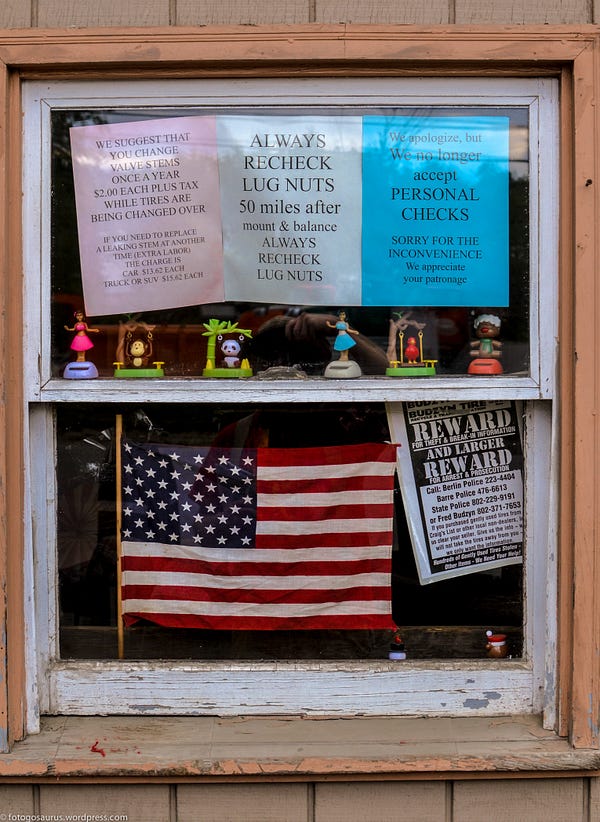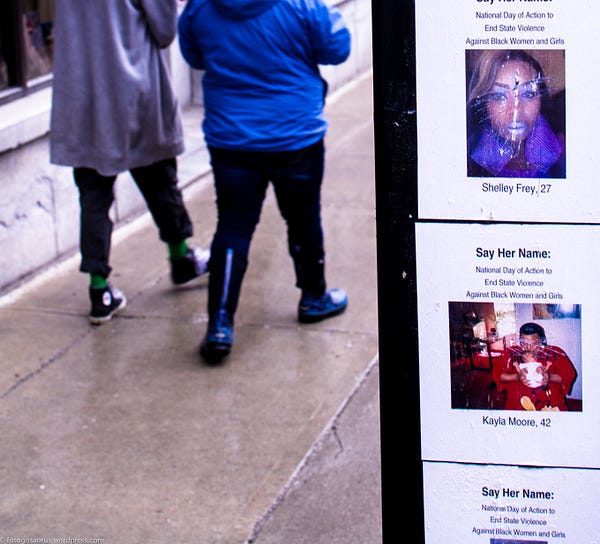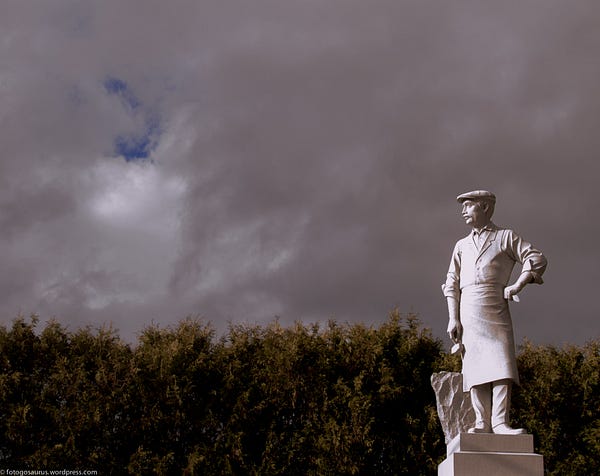Glover’s This Is America: The 4 Minute Invisible Man
There will be time to murder, and create
-T.S. Elliot, The Love Song of J. Alfred Prufrock
It was not Martin Luther King who emancipated the modern Negro, but Stepin Fetchit. It was Step, who elevated the Negro to the dignity of a Hollywood star. I made the Negro a first-class citizen all over the world
-Lincoln Theodore Monroe Andrew Perry, first black millionaire entertainer who played Stepin Fetchit

Donald Glover freezes his pose as the emptiness envelopes him. This is the first time, almost 3/4 of the way into his 4 minute, This Is Americavideo, that the man-himself is revealed. The person comes through the armor of performance. He catches his breath and holds his invisible pistol outstretched. The sheer act of doing nothing turns offense into defense. The gripping of a gun morphed into the the shackled hands of a slave being dragged. The bond is broken when the hands come down to his side. Glover catches his breath and smokes a joint. This fifteen seconds stretches into an eternity of repose. This is, as the Coca Cola company used to say, “the pause that refreshes”. Now Glover channels another great American performer, Bob Fosse. This multi-talented actor, performer, choreographer, singer, made an autobiographical feature, All That Jazz (1979), that highlighted the cost of even the most glorious showbiz career. Each day begins with the character facing the mirror and muttering “showtime”. Glover, a grammy winning vocalist in addition to being a television writer/actor/director, savors his break and takes Fosse’ cue for the video’s grand finale. Following an expansive intermission the lyric opens with “They gonna find you that blocka (blaow)” a reference to the drug used to revive opiate addicts who have fallen into a death spiral. This dire end seems to be the fate of the scores of people who appear in the background mimicking the harshness of underclass life and the never-ending carnage of the opioid crisis. Then comes a reprise of a grandmother’s admonishment of “get your money, BLACK MAN”. Followed by a message to those fans who follow him: “you motherfuckers owe me.” This is all encased in a tableaux of Glover dancing amidst a strange array of unstylish, out of date, automobiles. It is the mirror image of the boxing phenom Floyd Mayweather with his fleet of top of the line sports cars. It harkens back to Otis Redding’s riposte to Carla Thomas in the soul classic TRAMP, accusing him of being a hayseed. The man from the dock of the bay belts out his standing with a recitation of all his cars, “ I got six Cadillacs, five Lincolns, four Fords, Six Mecurys, Three T-Birds, Mustangs….” This ostentatious laundry list of vehicles confirms Otis’ underclass status. It is the same effect in Glover’s video as this moment, more than any other, merges him with the background of ghetto violence. In the somber closing number that follows, the lyrics use the metaphor of being a big dog, but chained in a backyard.

It’s hard to imagine Glover being restrained. This is someone who defines America in less time than it takes to cook a hard boiled egg. His nom de guerre, or more correctly nom de chanson, is “Childish Gambino”. It is an audacious moniker mashing callow innocence with one of New York’s most feared mafia families. There is ‘walk’ behind the ‘talk’. He has penned episodes of 30 Rock, as well as acting and producing his own much lauded shows. His side gig as a rapper has garnered a Grammy. Any one of these would have established a formidable career but this renaissance man of entertainment has one-upped himself with his definition of America. As of this writing, not even a month after its release, it has over 200 million views. What is everyone watching? Or, for that matter, who is everyone watching?
Glover is everything he isn’t. An African American who grew up in a central gathering spot for the modern Ku Klux Klan. A small town boy who collaborates with a wide a ray of international talent including Hiro Murai, the Japanese born director, and Sherrie Silver, the Rwandan born cheograpier. This entertainment juggernaut was raised as a Jehovah’s Witness, the radical Christian Sect that preaches against having birthday parties. His work, This is Americashould be titled Glover Agonistes. It begins as a world music pastoral and descends into a gangsta rap, free for all. Our hero/anti-hero starts as a master of ceremonies of a kaleidoscopic apocalypse and ends as a powerless victim being stalked by a mob. It is political, yet never leaves the orbit of being first class entertainment. It is a dystopian national anthem that peeks behind our imprimatur of optimism. The Europeans brought Liberté, égalité, fraternité, habeas corpus, in addition to slavery, mass lynching and genocide. It is not the ying/yang that intrigues Glover as much as the notion that enthusiastically taking sides is a requirement for citizenship. What do we do with those who refuse the neat characterizations of “good” and “bad”? Are they allowed to be Americans?

What is America? The video opens with a avuncular younger version of the Disney character, Uncle Remus, strumming a guitar. He isn’t singing his hallmark song of carefree slave-life, “Zip-A-Dee-Doo-Dah” but rather a modern palliative with an upbeat chorus about “partying”. Our anti-hero is revealed clad in the same outfit (no shirt, gold chains, white slacks) as an iconic 1970s image of Al Green, the romantic balladeer. It is a perfect set piece of escapist popular entertainment. Then the party ends rather abruptly. The camera glides back to the friendly guitarist. Now he is bound and gagged with a hood of white canvas. It brings to mind the the black clad Abu Ghraib Iraqi prison torture tableaux. Just as the scene is digested, Glover pulls out a pistol and executes him with one single shot to the back of the head. The music shifts into a discordant gangsta rap beat as someone steps off camera to retrieve the weapon with a red handkerchief. Our anti-hero dances and gives us his first lyrics, a hypnotic incantation of “This is America, Don’t Catch you slipping up”. It is an ironic puritanical call against the cardinal sin of LAZINESS but Glover is interested something more than being a scold against sloth.

Artistically This Is Americafollows the lead of other works of art that touch the zeitgeist by posing questions rather than giving answers. There is always danger mistaking the desire for understanding with a definitive version of the artist’s intent. Glover is clever enough not to be explicit or preach. He won’t talk about meaning. That is the job of the endless number of explanatory Youtube videos or bloggers such as myself. There is a sea of chatter regarding the closing moments of the video in which our anti-hero/hero is running in a tunnel of darkness. Is this a nod to the cocoon of darkness illustrated in Jordan Peele’s Get Out? Is it a reference to the thousands who ran down streets and through woods in their final moments before being lynched? Is this picking up themes from the prophetic novel Day of the Locust, which focuses onthe dark side of celebrity fandom? The questions mount as the images fade. Is the closing refrain “You just a Black man in this world” linked to Michael Kiwanuka’s “Black Man in a White World”? In that stunning video the singer/protagonist/antihero rises above a car crash caused by a police car as downtown LA loom in the background. Whatever the answers, the closing moments touch on the rarest commodity in entertainment, true emotion. The expression on Glover’s face is unabashed terror. It makes a lasting impression. The mob chasing him is amorphous lacking a specific grievance. Glover is guilty of being Glover but it would be a mistake to simply see him as a ‘stand in’ for people of color. This video has a larger resonance that the silos of race or gun control, to name just a few of the proposed cypher keys.

Everyone wants a piece of Glover. The entertainment industry, the political class, the general public have THE answers. He is supposedly supporting/fighting THEIR agendas. He is having none of it. He is a latter day Ralph Ellison, whose Invisible Man, escortiates anyone who thinks they have the asnwer to his questions. Ellison escoriates the academics, cultural hustlers, left- wing ideologues and black nationalists who wish to mold his anti-hero to their varied truths. Glover shares this defiant individualism that goes beyond the tags of “rapper”, “writer”, “black man”, “hero”. He is the hip Jehovah’s Witness who knows how to play the game better than the city folk. Ellison’s hero ends up a safe-room stealing power to enlighten himself with hundreds of electric lightbulbs. It is the victory of an introvert. On the inside Glover might feel as alienated but he is going to channel his revenge in a much louder spectacle. Ellison wrote, “I am invisible, understand, simply because people refuse to see me”. Glover counters with: I am invisible but people are going to see me because I’m going to light up the reality they don’t want to see.
During most of the vidoe Glover manages to carrying himself without expressing a particular of point of view. There are a panoply of emotional flashes of joy, laughter, surprise, horror, terror, menace… He is a empath channeling a background. A dull white industrial blankness that becomes peopled with figures committing various, crimes or hanging out in a stupor of unproductiveness. It is prize footage from our national daily diary, the local TV newscast. These are the moments of conception for our endless murders, riots car-jackings and mass shootings. Traditional gangsta rap videos might produce a chorus line of undulating seductive women clad in heels and bikinis. Always the contrarian, Glover gives us his cheerleading squad for this dystopian vision. It is a group of attractive young people of both sexes dressed in traditional gray toned private/charter/parochial school uniforms. This is the army of industry guiding our anti-hero along in his productivity. It is important to take note that these dancers are, unlike much of the eye candy that routinely fills these rolls, are expert performers with top notch choreography. The performers jump and undulate with Swiss-like precision which is masked behind seemingly genuine expressions of joy. There are moments that reprise the the ‘feel good’ vibe of the first minute, despite the urban riot erupting. Will we end this experience on a hopeful note? About half way through we know the answer is a definitive, NO! Glover enters a room filled with a traditional gospel choir. He acts coyly and sweetly admires these representatives of a storied African American institution. Their incantation is sung in an uplifting chorus but remains strangely foreboding: “Grandma told me, get your money black man”. Is Glover signaling Al Green’s path to redemption as a Gospel singing Reverend?

Unfortunately Gospel and R&B are dead. They were killed off by rap. Glover is going to get his own, HIS WAY. Suddenly he catches a machine gun thrown from off-camera. He shoots and the chorus’ blood is splattered on the white wall. As he casually walks away. Are we at the Sunday school at Emanuel AME in Charleston, where the Bible class was executed? Is this a reference to the First Baptist Church in Sutherland Springs, where the congregation was slaughtered? Or maybe we are taking a trip to the Tower at the University of Texas or Columbine or Sandy Hook or U of VA….. or maybe we are mourning Sam Cooke, the sweet-voiced Gospel singer turned pop sensation. He bled to death of gunshot wounds lying naked in the hallway of a seedy motel. No matter the horror, a unsettling routine kicks in that institutionalizes the carnage. The red-hankerchiefed gun retriever reprises his cameo and the weapon is whisked away. The first responders dutifully play their part as our anti-hero walks in the opposite direction continuing his parade of opposing emotions. The violent background movement increases. We witness carjacking, fire, suicide and other pantomimes of horror. Is that the horse of the apocalypse or General Lee lifted from the side of stone mountain? The music swells and a mantra of ‘not slipping’ intensifies. There is a camera pans overhead to children taking cell phone footage of the conflagrations. The dancing becomes more intricate and intense mimicking Glover’s outrageous faces. One minute he caricatures Beyonce, the next he seems bound in an African Dance ceremony or a black college fraturnity initiation ceremony. The lyrics make reference to contraband and “hunnid bands” (band of hundred dollar bills). The materialistic frenzy ends with that histrionic pose mimicking the shooting of a pistol. The “trigger” is pulled; then silence.
One can imagine a young African American boy looking at images of Lincoln on Mount Rushmore. It would have reminded him of the centerpiece of his hometown; the mirror image bas-relief homage to General Lee. Instinctively he might have known they were created by the same artist, Gutzon “John” Borglum. This sculptor, born in Idaho before it was officially a State, was a child of a polygamous marriage. The son of Danish immigrants, who belonged to a controversial religious sect, is an unlikely choice as the father of significant totems of Americana. But it wouldn’t surprise Donald Glover; after all, this is America. Get out of bed, look in the mirror and say “Showtime”. As the song says “Get your money, black man”. But he’s not just talking about black men and he’s not just talking about money. He’s explaining who he is by showing us what we’re not.



No comments:
Post a Comment